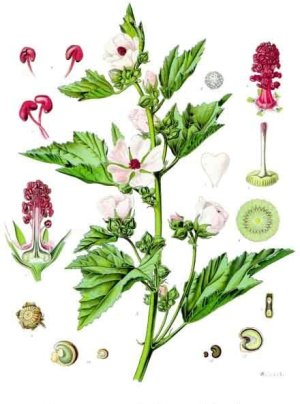I love roasting marshmallows. I am a slow, careful, over-the-coals, golden brown outside and gooey center inside marshmallow roaster. Although I spend most summer weekends sleeping in a tent, it’s not often that I get to roast sugary puffs, as I’m also a look-at-the-stars, read-a-book, Leave No Trace camper. The last time I had the privilege of roasting a marshmallow, I found myself wondering, “What the heck is this squishy ball of sugar and why are they an essential part of the American camping experience?”
First off, a little statistic from the National Confectioners Association: each year, Americans spend more than $125 million for 90 million pounds of marshmallow products.
It turns out that real marshmallows – not today’s perfectly white, mass produced variety found with Hershey’s bars and graham crackers in every grocery store/gas station/mini-mart, but sweets made from real marsh mallow plants – were once cough suppressants, immune system boosters, and wound healers.

Native to Egypt and true to its name, the pink flowered marsh mallow plant grows in swamps and bogs. While the entire plant – leaves, flowers, and root – is highly medicinal, it is the root that evolved into today’s sweet treat. Used for ages by Egyptians, sap from the root was used to soothe sore throats. In the 1800’s, the French altered the recipe, mixing the curative sap with rose water flavored egg white meringue and forming it in candy molds.
This resembled today’s sweet puffs, but candy stores had a hard time keeping up with demand, as the root extract was difficult to source and laborious to concoct. Thus, the healthful but sweet marsh mallow sap was replaced with gelatin and corn syrup, at which point the marshmallow candy was introduced to the United States. Finally, thanks to automated manufacturing processes introduced in the 1950’s, marshmallows could be mass produced and distributed to the average camper and they found their way into a variety of popular 1950’s recipes.
You don’t have to settle for modern day corn syrup mallows, but you may be hard pressed to find the real thing. But, you could try making your own marshmallows. Marsh mallow now grows across the globe, and is found in marshes of the U.S. from Kentucky north into the Great Lakes region and east to Massachusetts. The medicinal plant may even be on your local forest or in your backyard.
Few people make their own marshmallows today. Thus, aside from the curative powers of fresh air and toothy grins, it’s more than likely that the campfire confection you enjoy this 4th of July weekend will not boost your immune system or heal any wounds. But, you can rest assured that you’re not alone in helping to carry on a great American tradition – each summer, more than half of all marshmallows sold are toasted over a fire.

